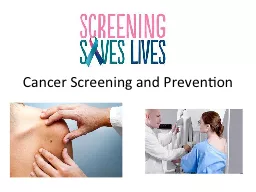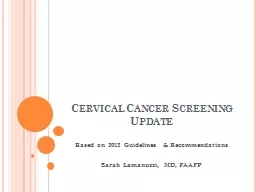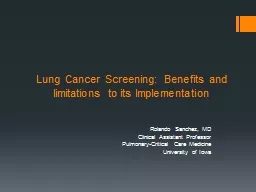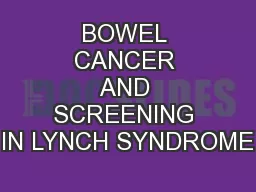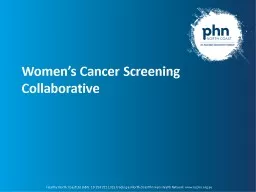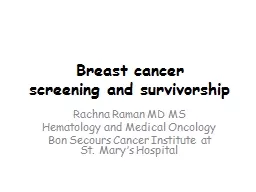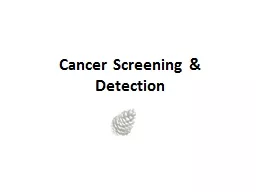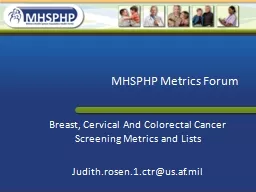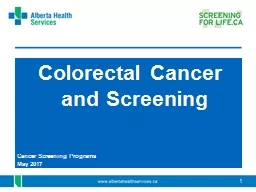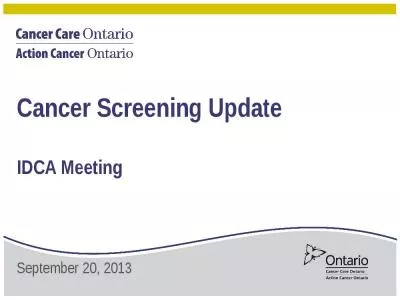PPT-Cancer Screening and Prevention
Author : cheeserv | Published Date : 2020-06-15
Screening Tests and Selfexams Screening tests Colon Breast Cervical Prostate Selfexams Testicular Skin Why Screening Tests The treatment of cancer is most successful
Presentation Embed Code
Download Presentation
Download Presentation The PPT/PDF document "Cancer Screening and Prevention" is the property of its rightful owner. Permission is granted to download and print the materials on this website for personal, non-commercial use only, and to display it on your personal computer provided you do not modify the materials and that you retain all copyright notices contained in the materials. By downloading content from our website, you accept the terms of this agreement.
Cancer Screening and Prevention: Transcript
Screening Tests and Selfexams Screening tests Colon Breast Cervical Prostate Selfexams Testicular Skin Why Screening Tests The treatment of cancer is most successful when the cancer is detected as early as possible often before symptoms occur. . KrisEmily. . McCrory. , MD. Objectives:. Review cervical cancer epidemiology and . pathophysiology. Identify the role of the Human . Papilloma. Virus in cervical cancer. Explain the use of HPV testing in cervical cancer screening. Based on 2012 Guidelines & Recommendations. Sarah Lamanuzzi, MD, FAAFP. Disclosures. I have no disclosures other than: the ASCCP gave permission for use of their slide content.. The American Society for Colposcopy and Cervical Pathology. “Cervical Cancer Screening Recommendations, . Rolando Sanchez, MD. Clinical Assistant Professor. Pulmonary-Critical Care Medicine. University of Iowa. Lung cancer - Epidemiology. Cancer statistics in US - 2011. Lung cancer - Epidemiology. Number of deaths from lung cancer in US - 2011. Nick Beck. Colorectal surgery, Southampton. BOWEL CANCER AND SCREENING IN LYNCH SYNDROME. How common is bowel cancer?. (How common is Lynch syndrome?). Screening guidelines for colonoscopy in Lynch syndrome. Healthy North Coast Ltd (ABN: 18 154 252 132), trading as North Coast Primary Health . Network www.ncphn.org.au. What is the WCSC?. A program to help you increase women’s participation in breast and cervical cancer screening. Rachna Raman MD MS. Hematology and Medical Oncology. Bon Secours Cancer Institute at St. Mary’s Hospital. Objectives. Risk factors . Screening guidelines and controversies. Screening and management of patients at high risk for breast cancer. Cancer Screening & Detection. What is cancer screening?. What should I ask my doctor about cancer screening?. What are the benefits of cancer screening?. Why is early detection important?. Today. Judith.rosen.1.ctr@us.af.mil. MHSPHP: Patients and Metrics. 2. Patient Detail View. Overview. Breast Cancer Screening. Clinical recommendations versus HEDIS. Metric versus Lists. Cervical Cancer Screening. Alon Z. Weizer, MD, MS. Associate Professor of Urology. Associate Chair, Surgical Services, . Department of Urology, University of Michigan. Disclosures. Summus (eConsult Platform): Advisory Board. Outline. Cancer Screening Programs . May 2017. How much do you know about colorectal cancer?. How common is colorectal cancer in Alberta? (i.e. 1 in X men and 1 in X women)?. How many cases of colorectal cancer can be treated successfully if found early (i.e. X out of 10)?. Stamatia Destounis, MD, FACR, FSBI, FAIUM. Elizabeth Wende Breast Care, LLC.. Clinical Professor. University of Rochester . School of Medicine and Dentistry. Background: Screening Mammography in the Aging Population. March 2019. Preview/Introduction. The Risk of Breast Cancer to Women. Does Mammography Save Lives?. When to Start and How Often Should Women Screen?. Risks Versus Benefits of Mammography. Breast Cancer: The Impact on Women. Jasmine Huang, MD. Director of Education and Program Development for Norton Thoracic Institute. Surgical Director, Lung Cancer Screening Program. November 21, 2019. Head and Neck Cancer Screening and Prevention. 1. Cancer Screening Update IDCA MeetingSeptember 20, 20132. OverviewOntario’s Cancer Screening ProgramsOntario Breast Screening Program (OBSP)CR Mammography Technology Transition Project23. Ontario’s Cancer Screening ProgramsOntario Breast...
Download Document
Here is the link to download the presentation.
"Cancer Screening and Prevention"The content belongs to its owner. You may download and print it for personal use, without modification, and keep all copyright notices. By downloading, you agree to these terms.
Related Documents

